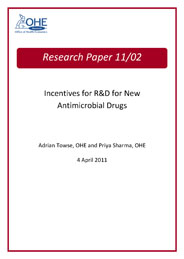Sign up to our newsletter Subscribe
Analysing Global Immunisation Expenditure

Antimicrobial resistance (AMR) is becoming a major global public health threat and has begun to command attention from European and US policy makers. An initial focus on monitoring AMR and conserving existing treatments by cutting down on misuse has been complemented by moves…
Antimicrobial resistance (AMR) is becoming a major global public health threat and has begun to command attention from European and US policy makers. An initial focus on monitoring AMR and conserving existing treatments by cutting down on misuse has been complemented by moves towards addressing the paucity of new drugs in the R&D pipeline of the pharmaceutical industry.
In this paper, authors identify five economic challenges: the utilisation externality; the lack of incentives for R&D arising from use restrictions, low prices, and scientific and regulatory challenges; the global joint sunk nature of R&D cost; the need for access to drugs in middle and low income countries; and failures in the market for point of care diagnostics. Recommended is a hybrid combination of “push” and “pull” incentives: higher prices linked to targeted use with diagnostic tests and/or an AMC-based “prize” for registering (but not necessarily using) desired new drugs, linked also to push measures.
The authors see US and European collaboration on incentives as desirable, but not if achieving agreement leads to delays. Action on conservation needs to be global and linked to use of new products. TRIPS provisions and national sensitivities on this issue present serious challenges, as seen in the 2010 reaction to evidence on the origins of NDM-1.
A revised version of this paper has been published in International Journal of the Economics of Business and can be downloaded from: http://www.tandfonline.com/doi/abs/10.1080/13571516.2011.584434
Please cite as: Towse, A. and Sharma, P., 2011. Incentives for R&D for new antimicrobial drugs. International Journal of the Economics of Business, 18(2), pp.331-350.
Incentives for R&D for New Antimicrobial Drugs
Towse, A. and Sharma, P.
(2011) Incentives for R&D for New Antimicrobial Drugs. OHE Grant-Funded Research. Available from https://www.ohe.org/publications/incentives-rd-new-antimicrobial-drugs/